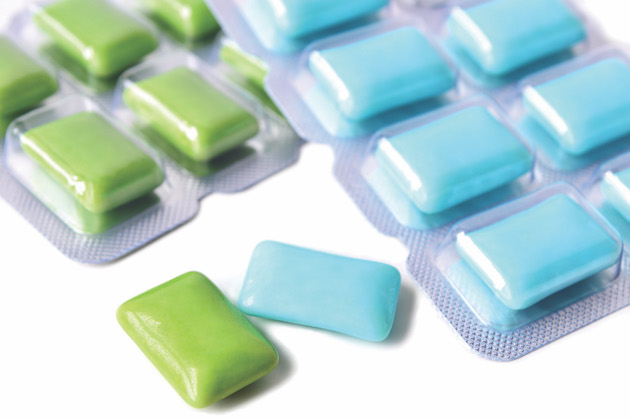Win CENS ProFlex DX5 earplugs worth £1,149 – enter here
Is chewing gum poisonous to dogs? What happens if my dog eats some?
 Chewing gum on white background
Chewing gum on white background
I’m often asked whether chewing gum is poisonous to dogs. Well, chewing gum is often sweetened with xylitol and the most common source of xylitol poisoning is chewing gum. It is important to note that, on packaging, xylitol may not be mentioned by name but by its food additive code, which is E967. Indeed, any medicine or product that is labelled ‘sugar free’ should be treated with suspicion, as it is likely to contain the substance. (Read why dogs shouldn’t eat chocolate.)
So what makes zylitol in chewing gum poisonous to dogs?
Xylitol stimulates insulin release in dogs, which can result in a rapid reduction in blood glucose. In one study, oral administration of xylitol caused an increase in insulin after only 20 minutes and blood glucose started to fall after half an hour. Liver enzymes had increased within four hours. When dogs swallow (rather than chew) chewing gum, however, it can be up to 12 hours before effects are seen, making diagnosis of the problem rather troublesome.
Hypoglycaemia (low blood glucose) is manifest in dogs by increased heart rate, unsteadiness on the feet, lethargy, weakness, vomiting, seizures, low blood pressure and ultimately coma, permanent brain damage and death. The reduction in blood glucose seen after xylitol ingestion is ‘dose dependent’.

Lethargy, weakness, unsteadiness and vomiting are symptoms of xylitol poisoning
Where do you find xylitol?
It is everywhere!
• Chewing Gum
• Nicotine replacement gums and lozenges
• Over-the-counter medicines, especially chewable products
• Toothpaste
• Diet bars
• Sugar substitutes for baking
• Ice cream
• Peanut butter
• Drink powders
• Biscuits, cakes, muffins, etc
• Sweets
• Some veterinary medicines
• Canine water additives that reduce plaque

Zylitol can be found in baking products and drink powders
How much is too much?
- 50-100mg/kg causes mild hypoglycaemia, which can be treated by giving small, frequent meals or sugar, along with medication to stop vomiting (anti-emetics).
- 100-500mg/kg causes significant hypoglycaemia, which should be treated at a vet, as monitoring of blood glucose and administration of intravenous dextrose is usually required.
- More than 500mg/kg can cause profound, prolonged hypoglycaemia and liver damage, so urgent treatment should be sought. Low potassium levels can be detrimental to heart function and bleeding disorders can occur.
Unknown dose
Of course, this sounds all well and good, but the ingested dose is generally unknown, as product packaging rarely contains the actual xylitol content. (And dogs often eat the packaging as well.) (Read our advice on how to make a dog vomit in an emergency.)
Different chewing gum products containing between 1% and 90% xylitol. A relatively new range of Starburst Gums, called Starburst Fruity Mixies, Starburst Strawberry Cubes and Starburst Red Berry Sticks are described as a cross between a gum and a sweet and contain more than 50% xylitol. These have been implicated in recent poisoning cases, as most people are unaware of the danger.
To date, I am not aware of any veterinary products or canine water additives, which reduce plaque formation, causing toxicity. In the latter, xylitol is present in very low concentration and it reduces dental plaque and tartar formation by inhibiting bacterial growth, which is beneficial to health, so don’t stop using them.
Where accidental ingestion of xylitol-containing products is discovered within the hour, it is worthwhile inducing vomiting to empty stomach contents. This requires owners to phone ahead to their vet and announce they are coming in and why. There is no point in sitting waiting, as time is of the essence.
Although xylitol does not bind well with activated charcoal, its use can still be beneficial. Dogs that are showing clinical signs of hypoglycaemia should not be given emetics due to the increased risk of aspiration.
What else could it be?
Hypoglycaemic-type clinical signs can be seen with a number of disorders, from pancreatic tumours to hypothyroidism and Addison’s disease. They also occur with insulin overdose (of course) and the ingestion of other drugs and toxins. Severe exertion and Hunting Dog Hypoglycemia should also be considered. I hope that this has given you something to chew over…
Related Articles
Get the latest news delivered direct to your door
Subscribe to Shooting Times & Country
Discover the ultimate companion for field sports enthusiasts with Shooting Times & Country Magazine, the UK’s leading weekly publication that has been at the forefront of shooting culture since 1882. Subscribers gain access to expert tips, comprehensive gear reviews, seasonal advice and a vibrant community of like-minded shooters.
Save on shop price when you subscribe with weekly issues featuring in-depth articles on gundog training, exclusive member offers and access to the digital back issue library. A Shooting Times & Country subscription is more than a magazine, don’t just read about the countryside; immerse yourself in its most authoritative and engaging publication.







